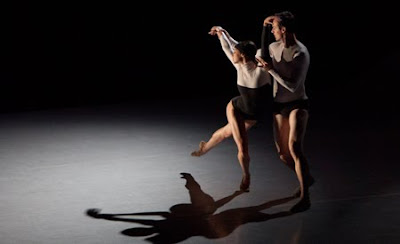
At The Joyce Theater, that premier venue for visiting dance companies, was the Aspen Santa Fe Ballet with a brand new piece, “Uneven.” Included in the program were two other pieces from the company’s repertory, “Stamping Ground” and “Red Sweet.” More modern dance than traditional ballet, this company formed in Colorado by Bebe Schweppe in 1996 and shared with Santa Fe (an unusual split residence arrangement) has risen to make annual visits in New York with its small ensemble of ten. “Uneven,” choreographed by Cayetano Soto, was a series of patterns and body contortions set to the live cello playing of Kimberly Patterson. The piece was about twenty minutes and the following intermission was just as long. When finally the curtain went up on “Stamping Ground,” choreographed by Jiri Kylián, the dancers emerged one by one to move through silence. As they joined each other they found synchronization without music or a beat to guide them. The series of animal-like movements began to grow tiresome until drumming came in to give the dance an exciting finish. “Stamping Ground” seemed like organized improvisation and felt like the kind of experimentation typical of young companies. Since the piece is from 1983, this makes sense. “Red Sweet,” Jorma Elo’s piece from 2008 was an involved and exciting dance, displaying the full range of talents of these seemingly super human dancers. Here were the turns, leaps and lifts of the classical ballet mixed with the company’s modern dance approach all set to the lively music of Vivaldi and Biber. I could have used an entire evening of that exhilarating stuff. In the end I realized (yet again), that the small modern ballet company on a bare stage with dancers in the simplest of black and white leotards just doesn’t do it for me. I long for the days of the Ballet Russes (which of course is before our time) and wonder why it is so rare to see that kind of dynamic and theatrical endeavor. Money is the main reason, but even for those companies that have the funds, it is still rare to see that kind of pioneering spirit that combines experimentation with new forms mixed with the art of design and a guiding theme that says something about humanity. This is not to say that small companies have not created ambitious and highly theatrical works on a small budget––they have, but we don’t see it too often. The easiest road is movement for movement’s sake and I have always looked for something more connected to human emotions than that––body mechanics alone are not enough.

The Joyce Theatre is another great example in New York of an old movie theater repurposed for improved use. This building was originally the Elgin Theatre of 1942. In the 1970s when the Elgin was reduced to triple X films, the neighborhood pressured for the theater’s closure by 1978. In the 1980s the theater was gutted to be turned into the current dance venue, though the original Moderne facade and marquee was restored.


